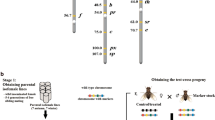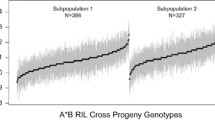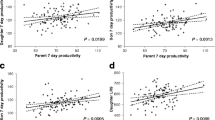Abstract
Relative to an equivalent source of variation that do not present a hidden state, cryptic genetic variation is likely to be an effective source for possible adaptations at times of atypical environmental conditions. In addition to environmental perturbations, it has also been proposed that genetic disturbances can generate release of cryptic genetic variation. The genetic basis and physiology of olfactory response in Drosophila melanogaster is being studied profusely, but almost no analysis has addressed the question if populations harbor cryptic genetic variation for this trait that only manifests when populations experiences a typical or novel conditions. We quantified olfactory responses to benzaldehyde in both larval and adult lifecycle stages among samples of chromosome two substitution lines extracted from different natural populations of Argentina and substituted into a common inbred background. We also evaluated whether an effect of genetic background change, occurred during chromosome substitution, affect larval and adult olfactory response in terms of release of cryptic genetic variation. Results indicate the presence of genetic variation among chromosome substitution lines in both lifecycle stages analyzed. The comparative analyses between chromosome 2 substitution lines and isofemale lines used to generate the chromosome 2 substitution lines shown that only adults exhibited decanalizing process for olfactory response to benzaldehyde in natural populations of D. melanogaster, i.e., release of hidden genetic variation. We propose that this release of hidden genetic variation in adult flies is a consequence of the shift in genetic background context that happens in chromosome 2 substitution lines, that implies the disruption of natural epistatic interactions and generation of novel ones. All in all, we have found that changes across D. melanogaster development influence visible and cryptic natural variation of olfactory behavior. In this sense, changes in the genetic background can affect gene-by-gene interactions (epistasis) generating different or even novel phenotypes as consequence of phenotypic outcome of cryptic genetic variation.





Similar content being viewed by others

References
Aceves-Piña, E. O., & Quinn, W. G. (1979). Learning in normal and mutant Drosophila larvae. Science, 206, 93–96.
Anholt, R. R. H., Dilda, C. L., Chang, S., Fanara, J. J., Kulkarni, N. H., Ganguly, I., et al. (2003). The genetic architecture of odor-guided behavior in Drosophila melanogaster: Epistasis and the transcriptome. Nature Genetics, 35, 180–184.
Anholt, R. R. H., Lyman, R. F., & Mackay, T. F. C. (1996). Effects of single P-element insertions on olfactory behavior in Drosophila melanogaster. Genetics, 143, 293–301.
Anholt, R. R. H., & Mackay, T. F. C. (2004). Quantitative genetic analyses of complex behaviours in Drosophila. Nature Reviews Genetics, 5, 838–849.
Anholt, R. R. H., & Mackay, T. F. C. (2015). Dissecting the genetic architecture of behavior in Drosophila melanogaster. Current Opinion in Behavioral Sciences, 2, 1–7.
Arya, G. H., Magwire, M. M., Huang, W., Serrano-Negron, Y. L., Mackay, T. F. C., & Anholt, R. R. H. (2015). The genetic basis for variation in olfactory behavior in Drosophila melanogaster. Chemical Senses, 40, 233–243.
Ayyub, C., Paranjape, J., Rodrigues, V., & Siddiqi, O. (1990). Genetics of olfactory behavior in Drosophila melanogaster. Journal of Neurogenetics, 6, 243–262.
Brown, E. B., Layne, J. E., Zhu, C., Jegga, A. G., & Rollmann, S. M. (2013). Genome-wide association mapping of natural variation in odour-guided behavior in Drosophila. Genes Brain Behavior, 12, 503–515.
Carlborg, O., Jacobsson, L., Ahgren, P., Siegel, P., & Andersson, L. (2006). Epistasis and the release of genetic variation during long-term selection. Nature Genetics, 38, 418–420.
Carreira, V. P., Imberti, M., Mensch, J., & Fanara, J. J. (2013). Gene-by-temperature interactions and candidate plasticity genes for morphological traits in Drosophila melanogaster. Plos one, 8(7), 1–10. doi:10.1371/journal.pone.0070851.
Chandler, C. H., Chari, S., & Dworkin, I. (2013). Does your gene need a background check? How genetic background impacts the analysis of mutations, genes, and evolution. Trends in Genetics, 29, 358–366.
Cobb, M., Bruneau, S., & Jallon, J. M. (1992). Genetic and developmental factors in the olfactory response of Drosophila melanogaster larvae to alcohols. Proceedings of the Royal Society of London: Biological Sciences, 248, 103–109.
Dworkin, I. (2005a). Canalization, cryptic variation, and developmental buffering: A critical examination and analytical perspective. In B. Hallgrimsson & B. K. Hall (Eds.), Variation (pp. 131–158). Burlington, MA: Elsevier Academic Press.
Dworkin, I. (2005b). A study of canalization and developmental stability in the sternopleural bristle system of Drosophila melanogaster. Evolution, 59, 1500–1509.
Falconer, D. S., & Mackay, T. F. C. (1996). Introduction to quantitative genetics. Essex, UK: Addison, Wesley, Longman.
Fanara, J. J., Robinson, K. O., Rollmann, M., Anholt, R. R. H., & Mackay, T. F. C. (2002). Vanaso is a candidate quantitative trait gene for olfactory behavior in Drosophila melanogaster. Genetics, 162, 1321–1328.
Flatt, T. (2005). The evolutionary genetics of canalization. The Quarterly Review of Biology, 80, 287–316.
Ganguly, I., Mackay, T. F. C., & Anholt, R. R. H. (2003). Scribble is essential for olfactory behavior in Drosophila melanogaster. Genetics, 164, 1447–1457.
Gerber, B., & Stocker, R. F. (2007). The Drosophila larva as a model for studying chemosensation and chemosensory learning: A review. Chemical Senses, 32, 65–89.
Gibson, G., & Dworkin, I. (2004). Uncovering cryptic genetic variation. Nature Reviews Genetics, 5, 681–690.
Gibson, G., & Wagner, G. (2000). Canalization in evolutionary genetic: A stabilizing theory? BioEssays, 22, 372–380.
Hermisson, J., & Wagner, G. (2004). The population genetic theory of hidden variation and genetic robustness. Genetics, 168, 2271–2284.
Houle, D. (1992). Comparing evolvability and variability of quantitative traits. Genetics, 130, 195–204.
InfoStat. (2008). InfoStat version 2008. Argentina: Universidad Nacional de Cordoba, Grupo InfoStat.
Kaiser, M., & Cobb, M. (2008). The behaviour of Drosophila melanogaster maggots is affected by social, physiological and temporal factors. Animal Behavior, 75, 1619–1628.
Lavagnino, N., Anholt, R. R. H., & Fanara, J. J. (2008). Variation in genetic architecture of olfactory behaviour among wild-derived populations of Drosophila melanogaster. Journal of Evolutionary Biology, 21, 988–996.
Lavagnino, N., Arya, G. H., Korovaichuk, A., & Fanara, J. J. (2013). Genetic architecture of olfactory behavior in Drosophila melanogaster: Differences and similarities across development. Behavior Genetics, 43, 348–359.
Le Cunff, Y., & Pakdaman, K. (2012). Phenotype-genotype relation in Wagner’s canalization model. Journal of Theoretical Biology, 134, 69–83.
Le Rouzic, A., & Carlborg, O. (2008). Evolutionary potential of hidden genetic variation. Trends Ecology and Evolution, 23, 33–37.
Lynch, M., & Walsh, B. (1998). Genetics and analysis of quantitative traits. Sunderland: Sinauer.
Mackay, T. F. C. (2014). Epistasis and quantitative traits: Using model organisms to study gene–gene interactions. Nature Reviews Genetics, 15, 22–33.
Mackay, T. F. C., Hackett, J. B., Lyman, R. F., Wayne, M. L., & Anholt, R. R. H. (1996). Quantitative genetic variation of odor-guided behavior in a natural population of Drosophila melanogaster. Genetics, 144, 727–735.
Masel, J., & Trotter, M. V. (2010). Robustness and evolvability. Trends in Genetics, 26, 406–414.
Mensch, J., Lavagnino, N., Carreira, V. P., Massaldi, A., Hasson, E., & Fanara, J. J. (2008). Identifying candidate genes affecting developmental time in Drosophila melanogaster: Pervasive pleiotropy and gene-by-environment interaction. BMC Developmental Biology, 8(78), 1–12. doi:10.1186/1471-213X-8-78.
Monte, P., Woodad, C., Ayer, R., Lilly, M., Sun, H., & Carlson, J. (1989). Characterization of the larval olfactory response in Drosophila and its genetic basis. Behavior Genetics, 19, 267–283.
Oppliger, F. Y., Guerin, P. M., & Vlimant, M. (2000). Neurophysiological and behavioral evidence for an olfactory function for the dorsal organ and a gustatory one for the terminal organ in Drosophila melanogaster larvae. Journal of Insect Physiology, 46, 135–144.
Paaby, A. B., & Rockman, M. V. (2014). Cryptic genetic variation: Evolution’s hidden substrate. Nature Reviews Genetics, 15, 247–258.
Pigliucci, M. (2010). Genotype–phenotype mapping and the end of the ‘genes as blueprint’ metaphor. Philosophical Transactions Royal Society B, 365, 557–566.
Polaczyk, P. J., Gasperini, R., & Gibson, G. (1998). Naturally occurring genetic variation affects Drosophila photoreceptor determination. Development Genes and Evolution, 207, 462–470.
Ramaekers, A., Magnenat, E., Marin, E. C., Gendre, N., Jefferis, G. S. X. E., Luo, L., & Stocker, R. F. (2005). Glomerular maps without cellular redundancy at successive levels of the Drosophila larval olfactory circuit. Current Biology, 15, 982–992.
Robertson, A. (1959). The sampling variance of the genetic correlation coefficient. Biometrics, 15, 469–485.
Rodrigues, V. (1980). Olfactory behavior of Drosophila melanogaster. In O. Siddiqi, P. Bvabu, L. M. Hall, & J. C. Hall (Eds.), Development and Neurobiology of Drosophila (pp. 361–372). London: Plenum Press.
Sambandan, D., Yamamoto, A., Fanara, J. J., Mackay, T. F. C., & Anholt, R. R. H. (2006). Dinamic genetic interactions determine odor-guided behavior in Drosophila melanogaster. Genetics, 174, 1349–1363.
Satorre, I., Fanara, J. J., & Lavagnino, N. (2014). Micro-geographical scale variation in Drosophila melanogaster larval olfactory behaviour is associated with host fruits heterogeneity. Entomologia Experimentalis et Applicata, 152, 23–30.
Spencer, C. C., Howell, C. E., Wright, A. R., & Promislow, D. E. (2003). Testing an ‘aging gene’ in long-lived Drosophila strains: Increased longevity depends on sex and genetic background. Aging Cell, 2, 123–130.
Stapley, J., Reger, J., Feulner, P. G. D., Smadja, C., Galindo, J., Ekblom, R., et al. (2010). Adaptation genomics: The next generation. Trends in Ecology and Evolution, 25, 705–712.
Swarup, S., Harbison, S. T., Hahn, L. E., Morozova, T. V., Yamamoto, A., Mackay, T. F. C., & Anholt, R. R. H. (2012). Extensive epistasis for olfactory behavior, sleep and waking activity in Drosophila melanogaster. Genetics Research, 94, 9–20.
Swarup, S., Huang, W., Mackay, T. F. C., & Anholt, R. R. H. (2013). Analysis of natural variation reveals neurogenetic networks for Drosophila olfactory behavior. Proceedings of the National Academy of Sciences of the United States of America, 110, 1017–1022.
Travisano, M., & Shaw, R. G. (2012). Lost in the Map. Evolution, 67, 305–314.
Vosshall, L. B., & Stocker, R. F. (2007). Molecular architecture of smell and taste in Drosophila. Annual Review of Neuroscience, 30, 505–533.
Wang, Y., Arenas, C. D., Stoebel, D. M., & Cooper, T. F. (2012). Genetic background affects epistatic interactions between two beneficial mutations. Biology Letters, 9, 1–4. doi:10.1098/rsbl.2012.0328.
Wright, D., Butlin, R. K., & Carlborg, O. (2006). Epistatic regulation of behavioural and morphological traits in the zebrafish (Danio rerio). Behavior Genetics, 36, 914–922.
Yamamoto, A., Anholt, R. R. H., & Mackay, T. F. C. (2009). Epistatic interactions attenuate mutations affecting startle behaviour in Drosophila melanogaster. Genetics Research, 91, 373–382.
Zhou, S., Campbell, T. G., Stone, E. A., Mackay, T. F. C., & Anholt, R. R. H. (2012). Phenotypic plasticity of the Drosophila transcriptome. PLoS Genetics, 8(3), e1002593. doi:10.1371/journal.pgen.1002593.
Zhou, S., Stone, E. A., Mackay, T. F. C., & Anholt, R. R. H. (2009). Plasticity of the chemoreceptor repertoire in Drosophila melanogaster. PLoS Genetics, 5(10), e1000681. doi:10.1371/journal.pgen.1000681.
Acknowledgments
The authors wish to thank T. F. C. Mackay (North Carolina State University, Raleigh, N.C., USA) for providing balancer lines. This work was supported by grants from Agencia Nacional de Promoción Científica y Tecnológica (PICT 2012-0640) and Consejo Nacional de Ciencia y Técnica (CONICET, PIP 112-200801-02042). NJL and JJF are members of Carrera del Investigador Científico of CONICET (Argentina).
Author information
Authors and Affiliations
Corresponding author
Ethics declarations
Conflict of interest
All authors declare that they have no conflict of interest.
Rights and permissions
About this article
Cite this article
Lavagnino, N.J., Fanara, J.J. Changes Across Development Influence Visible and Cryptic Natural Variation of Drosophila melanogaster Olfactory Response. Evol Biol 43, 96–108 (2016). https://doi.org/10.1007/s11692-015-9352-5
Received:
Accepted:
Published:
Issue Date:
DOI: https://doi.org/10.1007/s11692-015-9352-5



